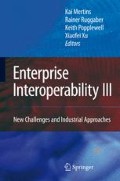Abstract
Today the concept of agility has become popular and is still growing in popularity in the management and technology literatures. How do we really define an agile information system? How do we know if an information system is agile? And how do we evaluate the agility in the context of enterprise information systems? This paper tries to answer some of these questions. It precisely aims to present the concept of agility of information systems and also provides an approach for the evaluation of this agility, namely POIRE approach that evaluates the agility as an amalgamation function that combines the agility measure of five complementary aspects that are Process, Organizational, Informational, Resource and Environmental aspects. Finally, this paper studies the role of interoperability in achieving agility and also the rapprochement of the concept of interoperability with the concept of agility.
Access this chapter
Tax calculation will be finalised at checkout
Purchases are for personal use only
Preview
Unable to display preview. Download preview PDF.
References
Abrahamsson P., Warsta J., Siponen M.T. and Ronkainen J., “New Directions on Agile Methods: A Comparative Analysis”. Proceedings of ICSE’03, 2003. pp. 244–254.
Adrian E., Coronado M. and Lyons A. C., “Investigating the Role of Information Systems in contributing to the Agility of Modern supply Chains”. In Desouza K. C. editor, Agile Information Systems: Conceptualization, Construction, and Management. Elsevier, Burlington, USA, ISBN 10: 0-7506-8235-3, 2007. pp. 150–162.
Ahsan M. and Ye-Ngo L. The relationship between IT infrastructure and strategic agility in organizations. In proceedings of the Eleven Americas Conference on Information Systems. N. C. Romano, Jr. editor, Omaha, NE. 2005.
Conboy K. and Fitzgerald B., “Towards a Conceptual Framework of Agile Methods: A Study of Agility in Different Disciplines”. ACM Workshop on Interdisciplinary Software Engineering Research, Newport Beach, CA, November 2004..
Desouza, K. C., “Preface”. In Desouza K. C. editor, Agile Information Systems: Conceptualization, Construction, and Management. Elsevier, Burlington, USA, ISBN 10: 0-7506-8235-3, 2007.
Dove R., “Response Ability: the Language, Structure and Culture of Agile Enterprise”. New York, Wiley, 2001.
Galliers R. D., “Strategizing for Agility: Confronting Information Systems Inflexibility in Dynamic Environments”. In Desouza K. C. editor, Agile Information Systems: Conceptualization, Construction, and Management. Elsevier, Burlington, USA, ISBN 10: 0-7506-8235-3, 2007. pp. 1–14.
Goldman S. et al., “21st Century Manufacturing Enterprise Strategy”. Brthlehem, PA: Iacocca Institute, Lehigh University. 1991.
Goranson H. T., “The Agile Virtual Enterprise, Cases, Metrics, Tools”. Quorum Books. 1999.
Heiler S., “Semantic Interoperability”. ACM Computing surveys, vol. 27, issue 2, pp. 271–273, 1995.
Houghton R. J. et al., “Vigilant Information Systems: The Western Digital Experience”. In Desouza K. C. editor, Agile Information Systems: Conceptualization, Construction, and Management. Elsevier, Burlington, USA, ISBN 10: 0-7506-8235-3, 2007. pp. 222–238.
Lui T-W. and Piccoli G., “Degrees of agility: Implications from Information systems Design and Firm Strategy”. In Desouza K. C. editor, Agile Information Systems: Conceptualization, Construction, and Management. Elsevier, Burlington, USA, ISBN 10: 0-7506-8235-3, 2007. pp. 122–133.
Lyytinen K. and Rose G. M., “The disruptive nature of IT innovations: The case of Internet computing in systems development organizations”. MIS Quarterly, 277(4), 2003. pp. 557.
Martensson A., “Producing and Consuming Agility”. In Desouza K. C. editor, Agile Information Systems: Conceptualization, Construction, and Management. Elsevier, Burlington, USA, ISBN 10: 0-7506-8235-3, 2007. pp. 41–51..
Mooney J. G. and Ganley D., “Enabling Strategic Agility Through Agile Information Systems”. In Desouza K. C. editor, Agile Information Systems: Conceptualization, Construction, and Management. Elsevier, Burlington, USA, ISBN 10: 0-7506-8235-3, 2007. pp. 97–109.
Oosterhout M. V., Waarts E., Heck E. V. and Hillegersberg J. V., “Business Agility: Need, Readiness and Alignment with it Strategies”. In Desouza K. C. editor, Agile Information Systems: Conceptualization, Construction, and Management. Elsevier, Burlington, USA, ISBN 10: 0-7506-8235-3, 2007. pp. 52–69.
Ross J. W. and Beath C. M., “Beyond the business case: New approaches to IT investment”. MIT Sloan Management Review, 43(2), 2002. pp. 51–59.
Rouse W. B., “Agile Information Systems for Agile Decision Making”. In Desouza K. C. editor, Agile Information Systems: Conceptualization, Construction, and Management. Elsevier, Burlington, USA, ISBN 10: 0-7506-8235-3, 2007. pp. 16–30.
Sambamurthy V., Bharadwaj A. and Grover V., “Shaping agility through digital options: Reconceptualising the role of information technology in contemporary firms”. MIS Quarterly, 27(2), 237–263. 2003.
Stamos E. and Galanou E., “How to evaluate the agility of your organization: Practical guidelines for SMEs”. VERITAS. 2006. Available at: http://www.veritaseu.com/files/VERITAS_D6_1_Agility_Evaluation_Handbook.pdf.
Tsourveloudis et al., “On the Measurement of Agility in Manufacturing Systems”. Journal of Intelligent and Robotic Systems, Kluwer Academic Publishers Hingham, MA, USA, 33(3) 2002. pp. 329–342.
Wensley A. and Stijn E. V., “Enterprise Information Systems and the Preservation of Agility”. In Desouza K. C. editor, Agile Information Systems: Conceptualization, Construction, and Management. Elsevier, Burlington, USA, ISBN 10: 0-7506-8235-3, 2007. pp. 178–187.
Wegner P., “Interoperability”. ACM Computing surveys, vol. 28, issue 1, 1996.
Wileden J. C. and Kaplan A., “Software Interoperability: principles and practice”. Proceedings of the 21st International Conference on Software Engineering (ICSE), pp. 675–676, ACM, 1999.
Wileden et al., “Specification level interoperability”. Proceedings of the 12th International Conference on Software Engineering (ICSE), pp. 74–85, ACM, 1990.
Author information
Authors and Affiliations
Editor information
Editors and Affiliations
Rights and permissions
Copyright information
© 2008 Springer-Verlag London Limited
About this paper
Cite this paper
Izza, S., Imache, R., Vincent, L., Lounis, Y. (2008). An Approach for the Evaluation of the Agility in the Context of Enterprise Interoperability. In: Mertins, K., Ruggaber, R., Popplewell, K., Xu, X. (eds) Enterprise Interoperability III. Springer, London. https://doi.org/10.1007/978-1-84800-221-0_1
Download citation
DOI: https://doi.org/10.1007/978-1-84800-221-0_1
Publisher Name: Springer, London
Print ISBN: 978-1-84800-220-3
Online ISBN: 978-1-84800-221-0
eBook Packages: EngineeringEngineering (R0)

